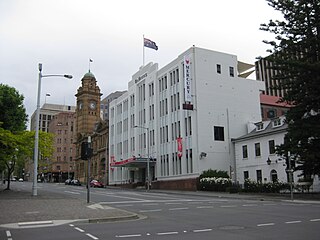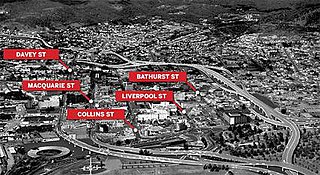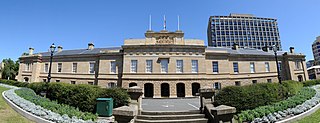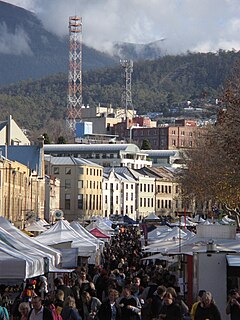The history of Tasmania begins at the end of the most recent ice age when it is believed that the island was joined to the Australian mainland. Little is known of the human history of the island until the British colonisation in the 19th century.

The Brooker Highway is a highway in the State of Tasmania, Australia. As one of Hobart's 3 major radials, the highway connects traffic from the Hobart city centre with the northern suburbs and is the major road connection to the cities and towns of Northern Tasmania. With an AADT of 48,000, the highway is one of the busiest in Tasmania. The Brooker Highway has recently been declared part of the National Highway.

Davey Street a major one way street passing through the outskirts of the Hobart Central business district in Tasmania, Australia. Davey street is named after Thomas Davey, the first Governor of Van Diemen's Land. The street forms a One-way couplet with nearby Macquarie Street connecting traffic from the Southern Outlet in the south with traffic from the Tasman Highway to the east and the Brooker Highway to the north of the city. With Annual average daily traffic of 37,200, the road is one of the busier streets in Hobart.

The Sydney central business district is the main commercial centre of Sydney, the state capital of New South Wales and the most populous city in Australia. It extends southwards for about 3 km (2 mi) from Sydney Cove, the point of first European settlement in which the Sydney region was initially established. Due to its pivotal role in Australia's early history, it is one of the oldest established areas in the country.

Macquarie Street a major one way street passing through the outskirts of the Hobart Central business district in Tasmania, Australia. Macquarie street is named after Lachlan Macquarie, who oversaw the planning of Hobart’s inner city grid layout. The street forms a One-way couplet with nearby Davey Street connecting traffic from the Southern Outlet in the south with traffic from the Tasman Highway to the east and the Brooker Highway to the north of the city. With annual average daily traffic of 28,500, the road is one of the busier streets in Hobart.
The modern history of the Australian city of Hobart in Tasmania dates to its foundation as a British colony in 1804. Prior to British settlement, the area had been occupied for at least 8,000 years, but possibly for as long as 35,000 years, by the semi-nomadic Mouheneener tribe, a sub-group of the Nuenonne, or South-East tribe. The descendants of the indigenous Tasmanians now refer to themselves as 'Palawa'.

Elizabeth Street is the major street which runs southeast to northwest through the city and suburbs of Hobart, Tasmania, Australia. It was named by the Governor of New South Wales from 1810-1821, Lachlan Macquarie, after his wife Elizabeth Macquarie. It starts at Sullivans Cove and runs northwesterly through the CBD of Hobart and the North Hobart shopping district, and changes to become New Town Road at the intersection with Augusta Road in New Town.

The Royal Hobart Regatta began in 1838, is a series of aquatic competitions and displays held annually in Hobart, Tasmania, Australia and is Tasmania's oldest sporting event. The regatta runs for three days, ending on the second Monday in February, and dominates the whole river for the duration of the event. The regatta of 6 February 1934 was the first to be called the Royal Hobart Regatta, the title being conferred by King George V.

The Doone Kennedy Hobart Aquatic Centre is a major, $17 million aquatic sporting facility located upon the Queens Domain, within less than 1 kilometre of the CBD of Hobart, the capital city of Tasmania, Australia. The venue has hosted the Australian Swimming Championships, the Tasmanian Swimming Championships, FINA Swimming World Cup, Pan Pacific Games and the Qantas Skins. Other major events held at the venue throughout its first seven years of operation include the Australian Canoe Polo Championships, Australian Diving Championships, Australian Water Polo Under Age and National League events and the World and Australian Underwater Hockey Championships.

The Hobart Rivulet, part of the River Derwent catchment, is an urban stream located in the Hobart hinterland and flows through and underneath the city, in Tasmania, Australia.

The Australian city of Hobart, Tasmania’s capital city, no longer has a network of trams operating, but it once had an extensive and popular system that reached the majority of Hobart suburbs. The Hobart tram network was established in 1893 by a private consortium known as the Hobart Electric Tram Company, providing Hobart with the first complete electric tramway in the Southern Hemisphere. Its fleet of double-decker trams were the only such trams in Australia.

The Hobart Bypass is a proposed concept to bypass the Central Business District of Hobart, Tasmania. Currently, through traffic travels from the Tasman/Brooker Highways down the one-way Davey/Macquarie couplet to the Southern Outlet. As well as traffic concerns, there is also a call to build the bypass on the grounds that the current traffic arrangement cuts the central business district off from Hobart's waterfront.

The ICON Complex is a low rise building in Hobart, Tasmania, situated in the city's centre. ICON Complex utilises access from of two main street fronts, Murray and Liverpool. The Myer department store is situated on Liverpool Street, replacing the Myer lost on the same site in 2007. The Liverpool Street site consists of the ICON Complex shopping centre, boasting many national and international brands including MECCA MAXIMA and Scotch and Soda (Clothing).

Liverpool Street is a street in the Central Business District of Hobart, in the state of Tasmania.

Argyle Street is a street in Hobart, Tasmania. The street was named by Lachlan Macquarie either in reference to Argyll, Scotland, where he grew up, or for the Duke of Argyll, head of Clan Campbell. Lachlan's wife had been born Elizabeth Campbell.





























